steering Seat Exeo 2010 Owner's Guide
[x] Cancel search | Manufacturer: SEAT, Model Year: 2010, Model line: Exeo, Model: Seat Exeo 2010Pages: 319, PDF Size: 9.64 MB
Page 192 of 319

Intelligent technology
190and prolongs the service life of the brakes. If you still have to use the brakes,
it is better to brake firmly at intervals than to apply the brakes continuously.
Note
If you wish to equip the vehicle with accessories such as a front spoiler or
wheel covers, it is important that the flow of air to the front wheels is not
obstructed, otherwise the brakes can overheat.Brake servo
The brake servo assists the driver when brakingThe brake servo increases the pressure you apply to the brake pedal. The
brake servo works only when the engine is running.
WARNING
Ensure the vehicle does not move while in neutral, when the engine is
stopped. Failure to do so could result in an accident.
Note
If the brake servo is not working, e.g. because the vehicle has to be towed or
because it is broken, you will have to press the brake pedal considerably
harder to make up for the lack of servo assistance.
Power steeringPower steering makes it easier to turn the steering wheel
when the engine is running.Power steering assists the driver by reducing the force needed to turn the
steering wheel.
Power steering does not work if the engine is off. In this case the steering
wheel requires much more force to turn.
If the steering is held at its turning limit when the vehicle is stationary, this
will place an excessive load on the power steering system. Turning the
steering wheel to its limit places a load on the system, which causes noise. It
will also reduce the idling speed of the engine.
Caution
When the engine is running, do not turn the steering wheel to its limit for
more than 15 seconds. Otherwise, there is a risk of damaging the power
steering.
Note
•If the power steering should fail at any time or the engine is switched off
(for instance when being towed), the vehicle can still be steered. However,
more effort will be required to turn the steering wheel.•If the system is leaking or malfunctioning, please take the vehicle to a
qualified workshop as soon as possible.•The power steering system requires a special hydraulic fluid. The fluid
reservoir is located at the front of the engine compartment on the left
⇒ page 295. The correct fluid level in the reservoir is important for the power
steering to function properly. The hydraulic fluid level is checked at the
Inspection Service.
exeo_EN.book Seite 190 Montag, 30. August 2010 4:45 16
Page 193 of 319

Intelligent technology191
Safety First
Operating Instructions
Practical Tips
Technical Specifications
Servotronic*The servotronic system electronically adjusts the power
assisted steering.In vehicles equipped with servotronic power steering the degree of power
assistance ⇒page 190 is adjusted electronically according to road speed.
If a fault should occur in the servotronic system, the power steering will still
operate. The degree of power assistance will, however, no longer adapt to
different speeds. If the electronic regulating system is not working properly,
this is most noticeable when turning the steering wheel at low speeds (for
instance when parking), as more effort will be required than usual. The fault
should be corrected by a qualified workshop as soon as possible.
exeo_EN.book Seite 191 Montag, 30. August 2010 4:45 16
Page 243 of 319
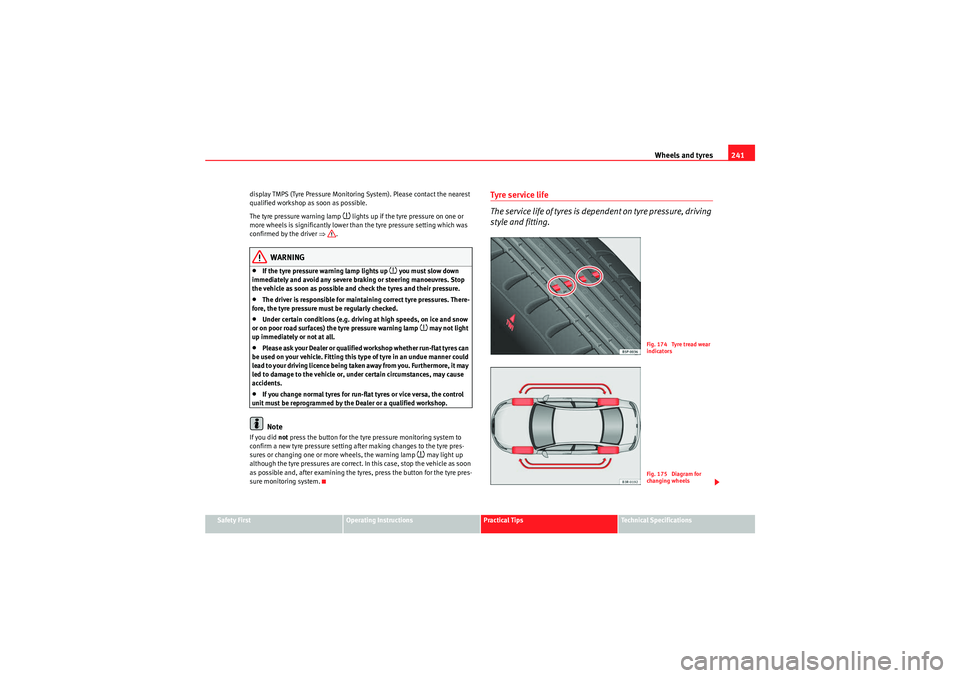
Wheels and tyres241
Safety First
Operating Instructions
Practical Tips
Technical Specifications
display TMPS (Tyre Pressure Monitoring System). Please contact the nearest
qualified workshop as soon as possible.
The tyre pressure warning lamp
�~ lights up if the tyre pressure on one or
more wheels is significantly lower than the tyre pressure setting which was
confirmed by the driver ⇒.
WARNING
•If the tyre pressure warning lamp lights up
�~ you must slow down
immediately and avoid any severe braking or steering manoeuvres. Stop
the vehicle as soon as possible and check the tyres and their pressure.
•The driver is responsible for maintaining correct tyre pressures. There-
fore, the tyre pressure must be regularly checked.•Under certain conditions (e.g. driving at high speeds, on ice and snow
or on poor road surfaces) the tyre pressure warning lamp
�~ may not light
up immediately or not at all.
•Please ask your Dealer or qualified workshop whether run-flat tyres can
be used on your vehicle. Fitting this type of tyre in an undue manner could
lead to your driving licence being taken away from you. Furthermore, it may
led to damage to the vehicle or, under certain circumstances, may cause
accidents.•If you change normal tyres for run-flat tyres or vice versa, the control
unit must be reprogrammed by the Dealer or a qualified workshop.Note
If you did not press the button for the tyre pressure monitoring system to
confirm a new tyre pressure setting after making changes to the tyre pres-
sures or changing one or more wheels, the warning lamp
�~ may light up
although the tyre pressures are correct. In this case, stop the vehicle as soon
as possible and, after examining the tyres, press the button for the tyre pres-
sure monitoring system.
Tyre ser vice life
The service life of tyres is dependent on tyre pressure, driving
style and fitting.
Fig. 174 Tyre tread wear
indicatorsFig. 175 Diagram for
changing wheels
exeo_EN.book Seite 241 Montag, 30. August 2010 4:45 16
Page 244 of 319
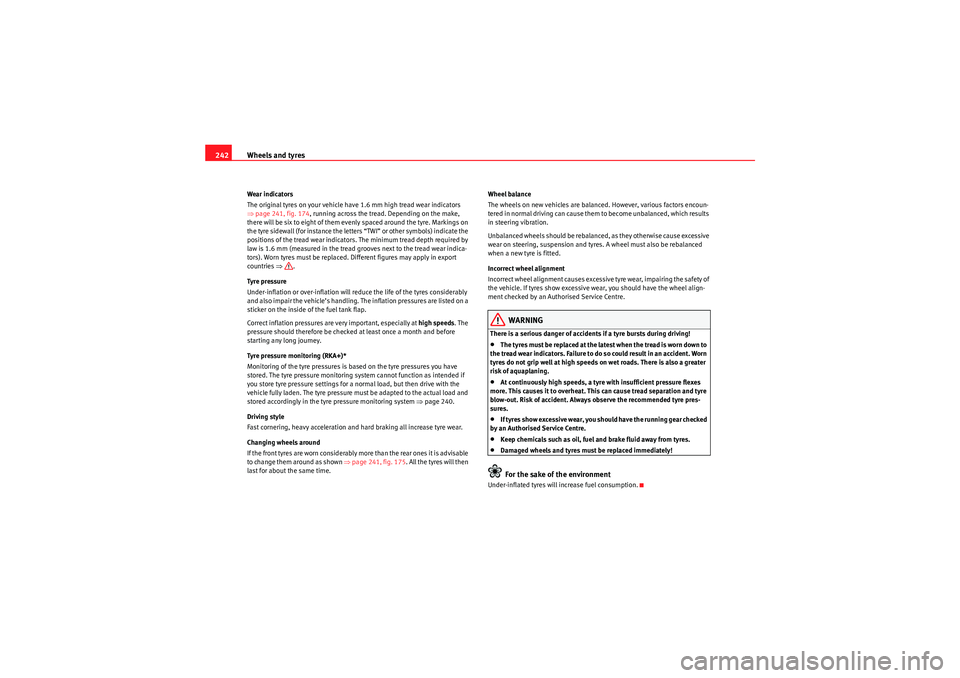
Wheels and tyres
242Wear indicators
The original tyres on your vehicle have 1.6 mm high tread wear indicators
⇒ page 241, fig. 174 , running across the tread. Depending on the make,
there will be six to eight of them evenly spaced around the tyre. Markings on
the tyre sidewall (for instance the letters “TWI” or other symbols) indicate the
positions of the tread wear indicators. The minimum tread depth required by
law is 1.6 mm (measured in the tread grooves next to the tread wear indica-
tors). Worn tyres must be replaced. Different figures may apply in export
countries ⇒.
Tyre pressure
Under-inflation or over-inflation will reduce the life of the tyres considerably
and also impair the vehicle’s handling. The inflation pressures are listed on a
sticker on the inside of the fuel tank flap.
Correct inflation pressures are very important, especially at high speeds. The
pressure should therefore be checked at least once a month and before
starting any long journey.
Tyre pressure monitoring (RKA+)*
Monitoring of the tyre pressures is based on the tyre pressures you have
stored. The tyre pressure monitoring system cannot function as intended if
you store tyre pressure settings for a normal load, but then drive with the
vehicle fully laden. The tyre pressure must be adapted to the actual load and
stored accordingly in the tyre pressure monitoring system ⇒ page 240.
Driving style
Fast cornering, heavy acceleration and hard braking all increase tyre wear.
Changing wheels around
If the front tyres are worn considerably more than the rear ones it is advisable
to change them around as shown ⇒page 241, fig. 175. All the tyres will then
last for about the same time. Wheel balance
The wheels on new vehicles are balanced. However, various factors encoun-
tered in normal driving can cause them to become unbalanced, which results
in steering vibration.
Unbalanced wheels should be rebalanced, as they otherwise cause excessive
wear on steering, suspension and tyres. A wheel must also be rebalanced
when a new tyre is fitted.
Incorrect wheel alignment
Incorrect wheel alignment causes excessive tyre wear, impairing the safety of
the vehicle. If tyres show excessive wear, you should have the wheel align-
ment checked by an Authorised Service Centre.
WARNING
There is a serious danger of accidents if a tyre bursts during driving!•The tyres must be replaced at the latest when the tread is worn down to
the tread wear indicators. Failure to do so could result in an accident. Worn
tyres do not grip well at high speeds on wet roads. There is also a greater
risk of aquaplaning.•At continuously high speeds, a tyre with insufficient pressure flexes
more. This causes it to overheat. This can cause tread separation and tyre
blow-out. Risk of accident. Always observe the recommended tyre pres-
sures.•I f t y r e s s h o w e x ce s s i v e w e a r, y o u s h o u l d h a v e t h e r u n n i n g g e a r ch e cke d
by an Authorised Service Centre.•Keep chemicals such as oil, fuel and brake fluid away from tyres.•Damaged wheels and tyres must be replaced immediately!For the sake of the environment
Under-inflated tyres will increase fuel consumption.
exeo_EN.book Seite 242 Montag, 30. August 2010 4:45 16
Page 261 of 319

If and when259
Safety First
Operating Instructions
Practical Tips
Technical Specifications
Fuse assignment
This list shows the fuses which can be replaced relatively
easily by the owner.No.
Consumer
Amps
1
Air conditioner
10
2
Footwell lamps
5
3
Heated washer jets
5
4
Radiator fan
5
5
Parking aid, automatic gearbox
10
6
Air conditioner (air purity sensor), pressure sensor
5
7
Electronic Stability Programme (ESP), brake light
switch, clutch pedal switch, steering angle sensor
10
8
Te le p hon e
5
9
Va can t
10
Adaptive headlights right
5
11
Airbag and disconnection of the front passenger air-
bag
5
12
Diagnostic socket
10
13
Steering column unit
10
14
Brake lights
10
15
Instrument panel
10
16
Va can t
17
Tyre pressure control, rain/light sensor
10
18
Adaptive headlights left
5
19
Va can t
20
Va can t
21
Va can t
22
Driver door / front passenger door
15
23
Rear doors
15
24
Central electrics unit for convenience equipment
20
25
Heater blower
30
26
Rear window heater
30
27
Power socket for trailer (control unit)
30
28
Fuel pump, auxiliary pump for diesel
20
29
Va can t
30
Sliding/tilting sunroof
20
31
Diagnosis connection, automatic anti-dazzle interior
mirror, reverse light, automatic gearbox
15
32
Towi ng s ocke t
15
33
Lighter
20
34
Lambda probe heater
5
35
Luggage compartment power socket*
20
36
Wiper system
30
37
Pump for windscreen washer and headlight washer
system
30
38
Luggage compartment illumination, alarm
15
39
Radio, Amplifier
20
40
Horn
25
No.
Consumer
Amps
exeo_EN.book Seite 259 Montag, 30. August 2010 4:45 16
Page 289 of 319

If and when287
Safety First
Operating Instructions
Practical Tips
Technical Specifications
Towing and tow-startingTo w - s t a r t i n g
The use of jump leads is pr eferable to tow-starting.We recommend that you do not tow-start your vehicle. Jump-starting
is preferable ⇒page 284.
However, if your vehicle has to be tow-started:
– Engage the 2nd or the 3rd gear.
– Keep the clutch pressed down.
– Switch the ignition on.
– Once both vehicles are moving, release the clutch.
– As soon as the engine starts, press the clutch and move the gear lever into neutral. This helps to prevent driving into the towing
vehicle.
WARNING
The risk of accidents is high when tow-starting. The vehicle being towed
can easily collide with the towing vehicle.
Caution
When tow-starting, fuel could enter the catalytic converter and damage it.
General notesPlease observe the following po ints if you use a tow-rope:
Notes for the driver of the towing vehicle
– Drive slowly at first until the tow-rope is taut. Then accelerate gradually.
– Begin and change gears cautiously. If you are driving an auto- matic vehicle, accelerate gently.
– Remember that the brake servo and power steering are not working in the vehicle you are towing. Brake earlier than you
would normally, but with a more gentle pressure on the brake.
Notes for the driver of the towed vehicle
– Ensure that the tow-rope remains taut at all times when towing.Tow-rope or tow-bar
It is easier and safer to tow a vehicle with a tow-bar. You should only use a
tow-rope if you do not have a tow-bar.
A tow-rope should be slightly elastic to reduce the loading on both vehicles.
It is advisable to use a tow-rope made of synthetic fibre or similarly elastic
material.
Attach the tow-rope or the tow-bar only to the towing eyes provided or a
towing bracket.
Driving style
Towing requires some experience, especially when using a tow-rope. Both
drivers should be familiar with the technique required for towing. Inexperi-
enced drivers should not attempt to tow-start or tow away another vehicle.
exeo_EN.book Seite 287 Montag, 30. August 2010 4:45 16
Page 290 of 319
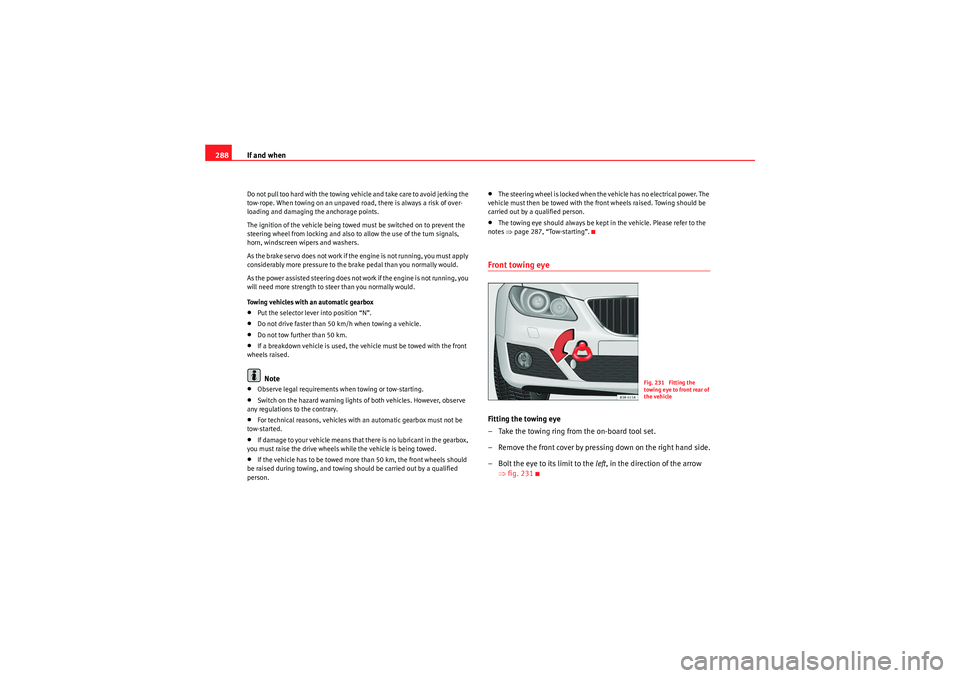
If and when
288Do not pull too hard with the towing vehicle and take care to avoid jerking the
tow-rope. When towing on an unpaved road, there is always a risk of over-
loading and damaging the anchorage points.
The ignition of the vehicle being towed must be switched on to prevent the
steering wheel from locking and also to allow the use of the turn signals,
horn, windscreen wipers and washers.
As the brake servo does not work if the engine is not running, you must apply
considerably more pressure to the brake pedal than you normally would.
As the power assisted steering does not work if the engine is not running, you
will need more strength to steer than you normally would.
Towing vehicles with an automatic gearbox•Put the selector lever into position “N”.•Do not drive faster than 50 km/h when towing a vehicle.•Do not tow further than 50 km.•If a breakdown vehicle is used, the vehicle must be towed with the front
wheels raised.Note
•Observe legal requirements when towing or tow-starting.•Switch on the hazard warning lights of both vehicles. However, observe
any regulations to the contrary.•For technical reasons, vehicles with an automatic gearbox must not be
tow-started.•If damage to your vehicle means that there is no lubricant in the gearbox,
you must raise the drive wheels while the vehicle is being towed.•If the vehicle has to be towed more than 50 km, the front wheels should
be raised during towing, and towing should be carried out by a qualified
person.
•The steering wheel is locked when the vehicle has no electrical power. The
vehicle must then be towed with the front wheels raised. Towing should be
carried out by a qualified person.•The towing eye should always be kept in the vehicle. Please refer to the
notes ⇒page 287, “Tow-starting”.Front towing eyeFitting the towing eye
– Take the towing ring from the on-board tool set.
– Remove the front cover by pressing down on the right hand side.
– Bolt the eye to its limit to the left, in the direction of the arrow
⇒ fig. 231
Fig. 231 Fitting the
towing eye to front rear of
the vehicle
exeo_EN.book Seite 288 Montag, 30. August 2010 4:45 16
Page 297 of 319
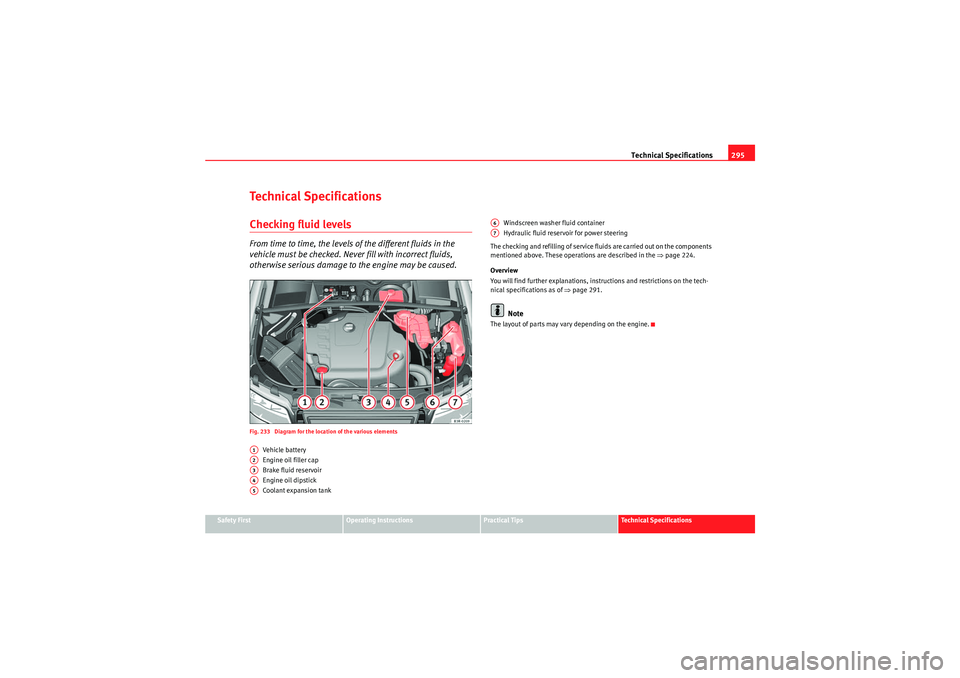
Technical Specifications295
Safety First
Operating Instructions
Practical Tips
Technical Specifications
Technical SpecificationsChecking fluid levelsFrom time to time, the levels of the different fluids in the
vehicle must be checked. Never fill with incorrect fluids,
otherwise serious damage to the engine may be caused.Fig. 233 Diagram for the location of the various elements
Vehicle battery
Engine oil filler cap
Brake fluid reservoir
Engine oil dipstick
Coolant expansion tank Windscreen washer fluid container
Hydraulic fluid reservoir for power steering
The checking and refilling of service fluids are carried out on the components
mentioned above. These operations are described in the ⇒page 224.
Overview
You will find further explanations, instructions and restrictions on the tech-
nical specifications as of ⇒page 291.
Note
The layout of parts may vary depending on the engine.
A1A2A3A4A5
A6A7
exeo_EN.book Seite 295 Montag, 30. August 2010 4:45 16
Page 309 of 319
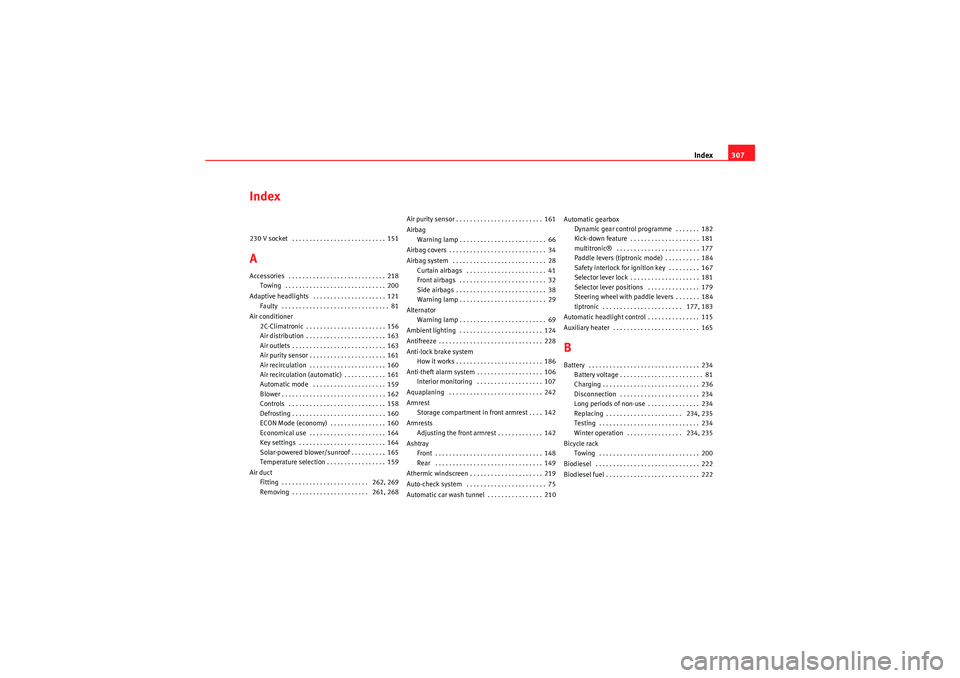
Index307
Index230 V socket . . . . . . . . . . . . . . . . . . . . . . . . . . . 151AAccessories . . . . . . . . . . . . . . . . . . . . . . . . . . . . 218
Towing . . . . . . . . . . . . . . . . . . . . . . . . . . . . . 200
Adaptive headlights . . . . . . . . . . . . . . . . . . . . . 121 Faulty . . . . . . . . . . . . . . . . . . . . . . . . . . . . . . . 81
Air conditioner 2C-Climatronic . . . . . . . . . . . . . . . . . . . . . . . 156
Air distribution . . . . . . . . . . . . . . . . . . . . . . . 163
Air outlets . . . . . . . . . . . . . . . . . . . . . . . . . . . 163
Air purity sensor . . . . . . . . . . . . . . . . . . . . . . 161
Air recirculation . . . . . . . . . . . . . . . . . . . . . . 160
Air recirculation (automatic) . . . . . . . . . . . . 161
Automatic mode . . . . . . . . . . . . . . . . . . . . . 159
Blower . . . . . . . . . . . . . . . . . . . . . . . . . . . . . . 162
Controls . . . . . . . . . . . . . . . . . . . . . . . . . . . . 158
Defrosting . . . . . . . . . . . . . . . . . . . . . . . . . . . 160
ECON Mode (economy) . . . . . . . . . . . . . . . . 160
Economical use . . . . . . . . . . . . . . . . . . . . . . 164
Key settings . . . . . . . . . . . . . . . . . . . . . . . . . 164
Solar-powered blower/sunroof . . . . . . . . . . 165
Temperature selection . . . . . . . . . . . . . . . . . 159
Air duct Fitting . . . . . . . . . . . . . . . . . . . . . . . . . 262, 269
Removing . . . . . . . . . . . . . . . . . . . . . . 261, 268 Air purity sensor . . . . . . . . . . . . . . . . . . . . . . . . . 161
Airbag
Warning lamp . . . . . . . . . . . . . . . . . . . . . . . . . 66
Airbag covers . . . . . . . . . . . . . . . . . . . . . . . . . . . . 34
Airbag system . . . . . . . . . . . . . . . . . . . . . . . . . . . 28 Curtain airbags . . . . . . . . . . . . . . . . . . . . . . . 41
Front airbags . . . . . . . . . . . . . . . . . . . . . . . . . 32
Side airbags . . . . . . . . . . . . . . . . . . . . . . . . . . 38
Warning lamp . . . . . . . . . . . . . . . . . . . . . . . . . 29
Alternator Warning lamp . . . . . . . . . . . . . . . . . . . . . . . . . 69
Ambient lighting . . . . . . . . . . . . . . . . . . . . . . . . 124
Antifreeze . . . . . . . . . . . . . . . . . . . . . . . . . . . . . . 228
Anti-lock brake system How it works . . . . . . . . . . . . . . . . . . . . . . . . . 186
Anti-theft alarm system . . . . . . . . . . . . . . . . . . . 106 Interior monitoring . . . . . . . . . . . . . . . . . . . 107
Aquaplaning . . . . . . . . . . . . . . . . . . . . . . . . . . . 242
Armrest Storage compartment in front armrest . . . . 142
Armrests Adjusting the front armrest . . . . . . . . . . . . . 142
Ashtray Front . . . . . . . . . . . . . . . . . . . . . . . . . . . . . . . 148
Rear . . . . . . . . . . . . . . . . . . . . . . . . . . . . . . . 149
Athermic windscreen . . . . . . . . . . . . . . . . . . . . . 219
Auto-check system . . . . . . . . . . . . . . . . . . . . . . . 75
Automatic car wash tunnel . . . . . . . . . . . . . . . . 210 Automatic gearbox
Dynamic gear control programme . . . . . . . 182
Kick-down feature . . . . . . . . . . . . . . . . . . . . 181
multitronic® . . . . . . . . . . . . . . . . . . . . . . . . 177
Paddle levers (tiptronic mode) . . . . . . . . . . 184
Safety interlock for ignition key . . . . . . . . . 167
Selector lever lock . . . . . . . . . . . . . . . . . . . . 181
Selector lever positions . . . . . . . . . . . . . . . 179
Steering wheel with paddle levers . . . . . . . 184
tiptronic . . . . . . . . . . . . . . . . . . . . . . . 177, 183
Automatic headlight control . . . . . . . . . . . . . . . 115
Auxiliary heater . . . . . . . . . . . . . . . . . . . . . . . . . 165
BBattery . . . . . . . . . . . . . . . . . . . . . . . . . . . . . . . . 234 Battery voltage . . . . . . . . . . . . . . . . . . . . . . . . 81
Charging . . . . . . . . . . . . . . . . . . . . . . . . . . . . 236
Disconnection . . . . . . . . . . . . . . . . . . . . . . . 234
Long periods of non-use . . . . . . . . . . . . . . . 234
Replacing . . . . . . . . . . . . . . . . . . . . . . 234, 235
Testing . . . . . . . . . . . . . . . . . . . . . . . . . . . . . 234
Winter operation . . . . . . . . . . . . . . . . 234, 235
Bicycle rack Towing . . . . . . . . . . . . . . . . . . . . . . . . . . . . . 200
Biodiesel . . . . . . . . . . . . . . . . . . . . . . . . . . . . . . 222
Biodiesel fuel . . . . . . . . . . . . . . . . . . . . . . . . . . . 222
exeo_EN.book Seite 307 Montag, 30. August 2010 4:45 16
Page 314 of 319
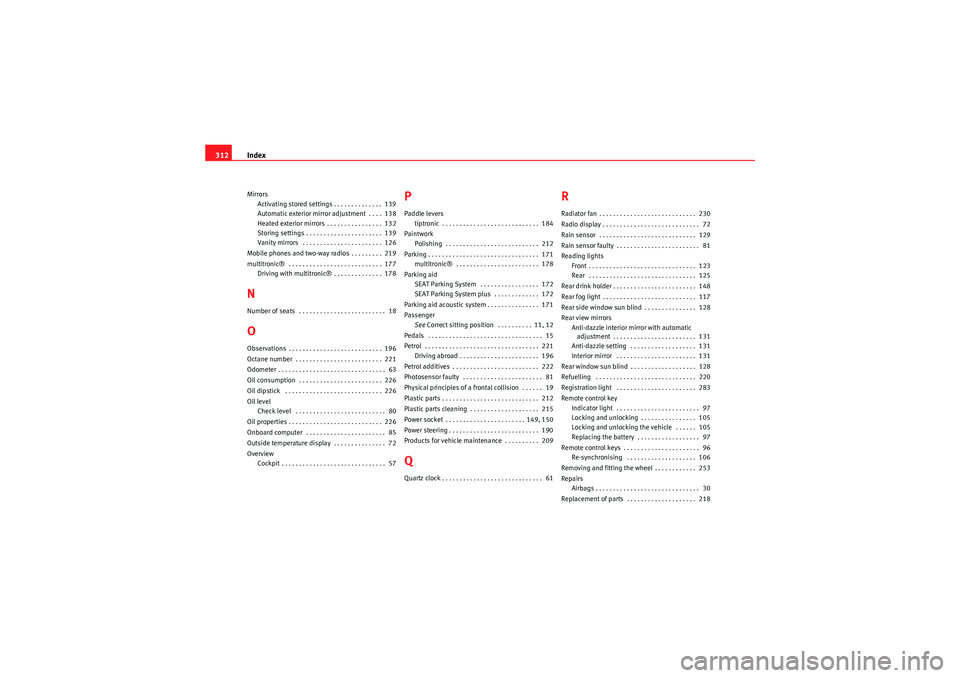
Index
312Mirrors
Activating stored settings . . . . . . . . . . . . . . 139
Automatic exterior mirror adjustment . . . . 138
Heated exterior mirrors . . . . . . . . . . . . . . . . 132
Storing settings . . . . . . . . . . . . . . . . . . . . . . 139
Vanity mirrors . . . . . . . . . . . . . . . . . . . . . . . 126
Mobile phones and two-way radios . . . . . . . . . 219
multitronic® . . . . . . . . . . . . . . . . . . . . . . . . . . . 177 Driving with multitronic® . . . . . . . . . . . . . . 178NNumber of seats . . . . . . . . . . . . . . . . . . . . . . . . . 18OObservations . . . . . . . . . . . . . . . . . . . . . . . . . . . 196
Octane number . . . . . . . . . . . . . . . . . . . . . . . . . 221
Odometer . . . . . . . . . . . . . . . . . . . . . . . . . . . . . . . 63
Oil consumption . . . . . . . . . . . . . . . . . . . . . . . . 226
Oil dipstick . . . . . . . . . . . . . . . . . . . . . . . . . . . . 226
Oil level
Check level . . . . . . . . . . . . . . . . . . . . . . . . . . 80
Oil properties . . . . . . . . . . . . . . . . . . . . . . . . . . . 226
Onboard computer . . . . . . . . . . . . . . . . . . . . . . . 85
Outside temperature display . . . . . . . . . . . . . . . 72
Overview Cockpit . . . . . . . . . . . . . . . . . . . . . . . . . . . . . . 57
PPaddle leverstiptronic . . . . . . . . . . . . . . . . . . . . . . . . . . . . 184
Paintwork Polishing . . . . . . . . . . . . . . . . . . . . . . . . . . . 212
Parking . . . . . . . . . . . . . . . . . . . . . . . . . . . . . . . . 171 multitronic® . . . . . . . . . . . . . . . . . . . . . . . . 178
Parking aid SEAT Parking System . . . . . . . . . . . . . . . . . 172
SEAT Parking System plus . . . . . . . . . . . . . 172
Parking aid acoustic system . . . . . . . . . . . . . . . 171
Passenger See Correct sitting position . . . . . . . . . . 11, 12
Pedals . . . . . . . . . . . . . . . . . . . . . . . . . . . . . . . . . 15
Petrol . . . . . . . . . . . . . . . . . . . . . . . . . . . . . . . . . 221 Driving abroad . . . . . . . . . . . . . . . . . . . . . . . 196
Petrol additives . . . . . . . . . . . . . . . . . . . . . . . . . 222
Photosensor faulty . . . . . . . . . . . . . . . . . . . . . . . 81
Physical principles of a frontal collision . . . . . . 19
Plastic parts . . . . . . . . . . . . . . . . . . . . . . . . . . . . 212
Plastic parts cleaning . . . . . . . . . . . . . . . . . . . . 215
Power socket . . . . . . . . . . . . . . . . . . . . . . . 149, 150
Power steering . . . . . . . . . . . . . . . . . . . . . . . . . . 190
Products for vehicle maintenance . . . . . . . . . . 209QQuartz clock . . . . . . . . . . . . . . . . . . . . . . . . . . . . . 61
RRadiator fan . . . . . . . . . . . . . . . . . . . . . . . . . . . . 230
Radio display . . . . . . . . . . . . . . . . . . . . . . . . . . . . 72
Rain sensor . . . . . . . . . . . . . . . . . . . . . . . . . . . . 129
Rain sensor faulty . . . . . . . . . . . . . . . . . . . . . . . . 81
Reading lights Front . . . . . . . . . . . . . . . . . . . . . . . . . . . . . . . 123
Rear . . . . . . . . . . . . . . . . . . . . . . . . . . . . . . . 125
Rear drink holder . . . . . . . . . . . . . . . . . . . . . . . . 148
Rear fog light . . . . . . . . . . . . . . . . . . . . . . . . . . . 117
Rear side window sun blind . . . . . . . . . . . . . . . 128
Rear view mirrors Anti-dazzle interior mirror with automatic adjustment . . . . . . . . . . . . . . . . . . . . . . . . 131
Anti-dazzle setting . . . . . . . . . . . . . . . . . . . 131
Interior mirror . . . . . . . . . . . . . . . . . . . . . . . 131
Rear window sun blind . . . . . . . . . . . . . . . . . . . 128
Refuelling . . . . . . . . . . . . . . . . . . . . . . . . . . . . . 220
Registration light . . . . . . . . . . . . . . . . . . . . . . . 283
Remote control key Indicator light . . . . . . . . . . . . . . . . . . . . . . . . 97
Locking and unlocking . . . . . . . . . . . . . . . . 105
Locking and unlocking the vehicle . . . . . . 105
Replacing the battery . . . . . . . . . . . . . . . . . . 97
Remote control keys . . . . . . . . . . . . . . . . . . . . . . 96 Re-synchronising . . . . . . . . . . . . . . . . . . . . 106
Removing and fitting the wheel . . . . . . . . . . . . 253
Repairs Airbags . . . . . . . . . . . . . . . . . . . . . . . . . . . . . . 30
Replacement of parts . . . . . . . . . . . . . . . . . . . . 218
exeo_EN.book Seite 312 Montag, 30. August 2010 4:45 16